Sitting Ducks
The Threat to the Chemical and Refinery
Industry From 50 Caliber Sniper Rifles
Section Two: Industrial Targets and the 50 Caliber Sniper Rifle
In the wake of the
attacks on the World Trade Center and the Pentagon, experts have said
that anti-terror analysis must focus on simultaneous attacks mounted
by relatively simple conventional means, but capable of inflicting catastrophic
damage.37
The materiel-destroying
capability of the 50 caliber sniper rifle is precisely such a means:
leveraging readily available low technology to achieve disastrous high-technology
results. The 50 caliber rifle's anti-materiel capabilities include:
- Turning chemical
or other industrial facilities into bombs, with the potential for
mass casualties.
- Explosive attacks
on bulk fuel carriers or storage depots, including the risk of fratricidal
explosions spreading damage to catastrophic levels.
The more catastrophic
scenarios could result in the deaths of the attackers themselves. However,
given the suicide attacks we have already experienced, this is no bar
to the feasibility of such operations. "Closed-circuit TV [monitoring]
works with the IRA, because their method is they don't want to be caught,"
a British transit police official explained recently. "It wouldn't work
with a suicide operator."38
Turning Hazardous Chemical Facilities Into Weapons
A substantial amount
of attention has been given to the interest of Osama bin Laden's al
Qaeda, and other terrorist organizations, in obtaining and using chemical
weapons, and analyzing the likelihood of it acquiring such weapons.39
But experts have warned also of the threat of another type of attack,
similar in concept to using commercial aircraft as bombs—turning hazardous
industrial facilities themselves into chemical weapons.
As noted in the
Introduction to this report, a 1999 blue-ribbon panel report to the
President and Congress warned that "a terrorist interested in harming
large numbers of persons might prefer to attempt to engineer a chemical
disaster using conventional means to attack an industrial plant or storage
facility, rather than develop and use an actual chemical weapon. In
this way, significant technical and resource hurdles could be overcome,
as well as reducing the profile of the terrorist organization to potential
detection by intelligence or law enforcement agencies."40
The U.S. Department
of Justice issued a 2000 report in which it "concluded that the risk
of terrorists attempting in the foreseeable future to cause an industrial
chemical release is both real and credible. Increasingly, terrorists
engineer their attacks to cause mass casualties to the populace and/or
large-scale damage to property. Terrorists or other criminals are likely
to view the potential of a chemical release from an industrial facility
as a relatively attractive means of achieving these goals."41
In May 2001, the
U.S. Environmental Protection Agency (EPA) issued an alert that appeared
to respond to the 1999 blue-ribbon panel's report. EPA warned local
chemical disaster advisory committees that "a terrorist may seek to
transform a target into a weapon by focusing on facilities that handle
explosive, toxic, or volatile chemicals."42 The advisory warned facilities
"with chemicals or explosive storage" to take site security measures.43
One might think
that this is a rare threat affecting only a few people unfortunate enough
to live in a heavily industrial area. That would be a mistake. The most
hazardous chemical and industrial facilities in the United States are
required to report on their plans for dealing with escape of substance
off-site. Of some 15,000 that had reported as of last year, almost half
reported that "over 1,000 people live in zones that could be affected
by the release of toxic chemicals from those facilities."44
The threat of this
type of engineered chemical attack is so serious that many federal agencies
have within recent days removed data about hazardous locations from
their Internet web sites.45 What must also be asked is: what kind of weapons
would be ideal for such attacks?
An engineered attack
on such a facility could have disastrous ripple effects as well. Numerous
facilities critical to the nation's infrastructured are located at or
near hazardous sites. "Disruption of even one of these facilities could
wreak havoc on an entire region or locality,"46 the Justice Department
warns. "A chemical release may be more effective than a bomb in causing
such disruption, since a leak of toxic chemicals may necessitate large-scale
evacuation."47
Foreign and domestic
terrorists alike have already considered such schemes. For example,
members of the Ku Klux Klan plotted to bomb a hydrogen sulfide tank
at a refinery near Dallas in 1997.48 According to the chief of the FBI's
domestic terrorist section, they discussed the potential of hundreds
of deaths, including children, which they hoped to use as a diversion
for a planned armored car robbery.49 The plot was foiled because an informant
tipped off authorities, but the potential is nonetheless instructive.
ILLUSTRATION TWO:
TANK FARMS ARE IDEAL 50 CALIBER TARGETS
U.S. military manuals
and manufacturer advertising identify bulk fuel storage as intended
targets of 50 caliber anti-materiel sniper rifles. The first tank farm
below illustrates a collateral hazard—it is within yards of a major
interstate highway. The second fuel tank farm below illustrates a similar
collateral hazard—it is located next to a shopping mall and commercial
strip in a residential suburb of a major East Coast city. Attacks with
armor-piercing ammunition on similar sites storing toxic chemicals could
endanger tens of thousands of nearby inhabitants.
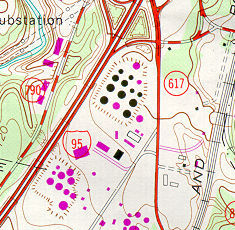
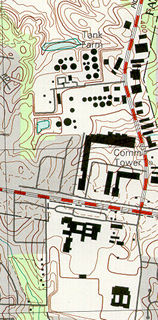
The threat of an
engineered chemical disaster is clearly real. How capable the country
is of responding to such a threat is another open question—in 2000,
Congress instructed the Justice Department to study how well chemical
plants are prepared to prevent terrorist attacks, but did not fund the
study.50 Chemical facilities were put on alert after the September 11
attacks.51 But, the question is, what likely means of attack are they
on the alert for?
It takes little
imagination to understand the threat from a 50 caliber sniper rifle
firing a dramatically explosive and incendiary round like the Raufoss
MP from a distance of several thousand yards (or even more, since the
target is likely to be big enough to be hit at the farthest manageable
range).
Attacks on Explosive Materials in Transit or Bulk Storage
Bulk storage of
hazardous chemicals and fuels, and their transportation in bulk by truck
and rail networks, presents many other targets for catastrophic attack
by terrorists armed with 50 caliber sniper rifles and the armor-piercing,
incendiary, and explosive ammunition widely available for them. In addition
to the direct effects of explosions or contamination such attacks would
cause, collateral effects could be shutdowns and massive dislocations
throughout surface transportation and communications networks, and other
vital parts of the critical infrastructure.
If the threat is
not self-evident, one need only consider the vast number of bulk fuel
storage facilities in the United States—such as gasoline and propane—and
match that number with the incendiary power of the advanced 50 caliber
rounds available to terrorists. Add to that problem the 50,000 trucks
hauling millions of pounds of toxic, flammable, and explosive cargo
over America's highways, and countless railcars loaded with hazardous
material such as fuels and chlorine gas, the ability of a terrorist
to inflict damage with the explosive firepower of the 50 caliber sniper
rifle becomes almost unimaginable.52
This is not conjecture.
Terrorists in the United States have plotted assaults on such facilities.
Disastrous accidents involving bulk storage and bulk transport of hazardous
materials have shown the potential consequences of a terrorist attack.
The potential effects of a carefully planned attack could go far beyond
the random effects of an accident. It is worth noting that 50 caliber
enthusiasts trade tips over the Internet about the best ways to shoot
commercially available propane tanks to cause them to explode. What
is missing is an official response tying these strands together.
Consider, for example,
the ubiquity of propane gas storage facilities and the transportation
of propane on public roads and rail networks all over the country, every
working day. The propane industry goes to great lengths to make delivery
and use safe, but the fact remains that it is a highly explosive fuel
when improperly released. "A propane fire is a more powerful monster
than the fires these heroes [firefighters] usually face," advised one
materials-handling publication.53 The second most deadly chemical accident
in history—after Bhopal—was a catastrophic chain of explosions set off
at a propane gas distribution center in Mexico City in 1984.54 The death
total was nearly 500, at least 4,000 were injured, 2,000 houses in a
20 block area were leveled, and thousands were left homeless.55
The United States
has not been immune to serious accidents involving propane facilities.56
An accidental propane release and fire near Des Moines, Iowa, in 1998
caused the evacuation of 10,000 residents and the closing of an interstate
highway.57 An EPA official described a 1989 explosion involving ethylene
and isobutane, "both of which have similar flammability characteristics
as propane" as being "the equivalent of 10 tons of TNT."58
The potential for
unleashing disaster by igniting a propane tank has not escaped domestic
terrorists. A plot by members of a militia group to blow up a giant
propane storage facility in Elk Grove, California, was derailed when
federal agents arrested them in December 1999 after an undercover investigation.59
The facility holds about 24 million gallons of propane and is a few
hundred yards from a busy state highway and other industrial buildings.
A study by Lawrence Livermore National Laboratory concluded that, had
the attack been successful, it would have caused a firestorm that would
have reached about 10 miles from the facility and caused a fatality
rate as high as 50 percent up to five miles away.60
On a far smaller
scale, an environmental terror group in Maine attempted to blow up a
fish and game club with a propane tank, but a club member who was a
fireman noticed the device and disabled it.61
There are about
33,000 propane facilities nationwide.62 Bulk storage tanks at these facilities
range in size from 6,000 to 120,000 gallons, and several tanks of various
sizes may be found at any one facility.63
According to the
U.S. Department of Transportation, "propane releases are a leading cause
of death in hazardous material transportation."64 Semi-trailer bulk cargo
tank vehicles that distribute propane over long-haul distances have
capacities ranging from 9,000 to 17,000 gallons.65 Smaller "bobtail" trucks
deliver propane locally to customers that have propane containers on
site, and have tank capacities from 750 to 6,500 gallons.66 Railroad tank
cars that deliver from refineries and gas plants to bulk tanks have
capacities of between 11,000 and 34,500 gallons.67
ILLUSTRATION THREE:
POTENTIAL ATTACKS ON BULK TRANSPORT OF HAZARDOUS MATERIALS
Attacks on liquid
oxygen in bulk storage or being transported by tank trucks, as illustrated
here, or on railcars could have explosive consequences. A well-planned
attack on a location near key infrastructure would have devastating
collateral effects. Tens of thousands of fuel trucks travel on highways
every day, vulnerable to attack by long-range 50 caliber incendiary
ammunition. Unintentional fires have already had devastating effects
on transportation networks. Deliberate attacks could be far worse.
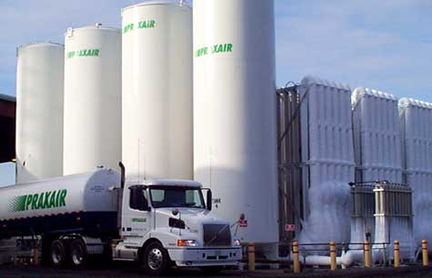
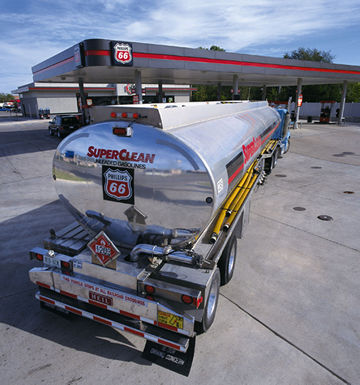
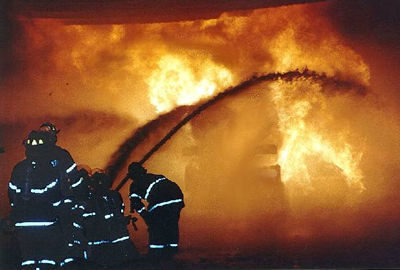
Terrorists have already
targeted bulk transporters. In 2000, for example, two anarchists in
Oregon tried to ignite a 12,000-gallon gasoline tanker, using a crude
milk-jug bomb with a delayed igniter. The device failed, but police
said it would have caused a catastrophic explosion had it succeeded.68
The consequences of a successful attack with armor-piercing incendiary
rounds on such a bulk tanker, or a bulk storage facility, could be disastrous—even
if the attackers were themselves incinerated in the resulting explosion.
A successful attack
with armor-piercing incendiary rounds on railcars or trucks carrying
flammable or explosive cargo could create geometrically increasing ripple
effects if the attack occurred at or near a crucial site, such as a
key bridge or tunnel, a national security facility, or a hazardous industrial
site. This issue is addressed in the next paragraphs.
Damaging Critical Infrastructure Networks Sufficiently to Cause Widespread
Disruption
There are a variety
of ways in which a successful attack by a terrorist exploiting the 50
caliber sniper rifle's capabilities could cause widespread disruption
involving critical infrastructures.
One of the more
obvious was alluded to in the preceding section—the collateral consequences
of a successful attack with armor-piercing incendiary rounds on a bulk
truck or rail carrier of fuel or other highly flammable material at
a key location. "It strikes me that railroads are far more vulnerable
in many ways than our airplanes," West Virginia Senator Jay Rockefeller
said during a recent Senate hearing on the risk of terror to the nation's
surface transportation systems.69
Gasoline tanker
fires have had serious collateral effects. A three-truck accident that
set off a gasoline-tanker truck explosion on a bridge shut down a major
artery between Pennsylvania and New York for days, forcing tens of thousands
of vehicles to find alternate routes.70
Instruction in the
potential consequences abound in examples of accidents. Earlier this
year, for example, a train fire in a tunnel under Baltimore caused an
"enormous snarl" in rail traffic on the Eastern seaboard for nearly
a week, drawing attention to a large number of potential bottlenecks
in the railroad system.71 The fire in the tunnel also destroyed fiber-optic
cables, slowing Internet traffic all over the country,72 and released
toxic chemicals from ruptured tank cars.73 Similar explosions last year
shut down a major bridge in Jacksonville, Florida, and a highway in
Nevada.74
A Florida collision
between a gasoline-tanker truck and a tractor-trailer hauling 20 tons
of ammonium nitrate threatened to cause an enormous explosion, had the
gasoline mixed with the chemical, the major ingredient of many truck
bombs such as the one Timothy McVeigh set off in Oklahoma City in 1995.
Firefighters were forced to stand by and let the fire die down, rather
than risk dispersing the gasoline and mixing it with the spilled ammonium
nitrate.75
These examples were
accidents. It does not take a great deal of imagination to project the
mentality of a terrorist, the range of the 50 caliber sniper rifle,
and the incendiary effects of its ammunition to imagine carefully planned
scenarios with even greater immediate and collateral effects.
d) The critical
infrastructure includes such things as water supply, military installations,
utility companies, natural gas distribution, as well as electrical and
communications networks.
Back
to Table of Contents
All contents © 2002 Violence Policy Center
The Violence Policy Center is a national non-profit educational foundation
that conducts research on violence in America and works to develop violence-reduction
policies and proposals. The Center examines the role of firearms in America,
conducts research on firearms violence, and explores new ways to decrease
firearm-related death and injury. |